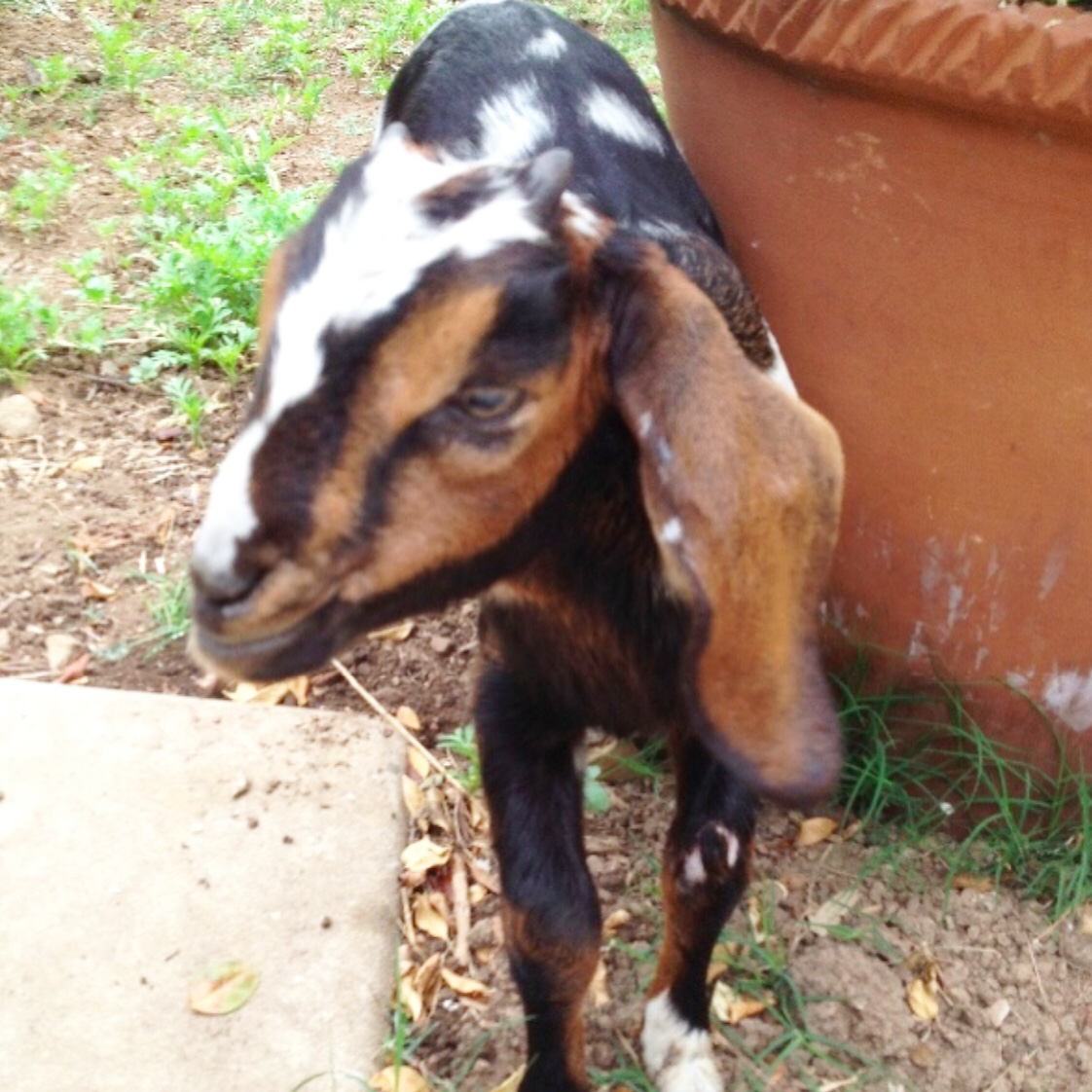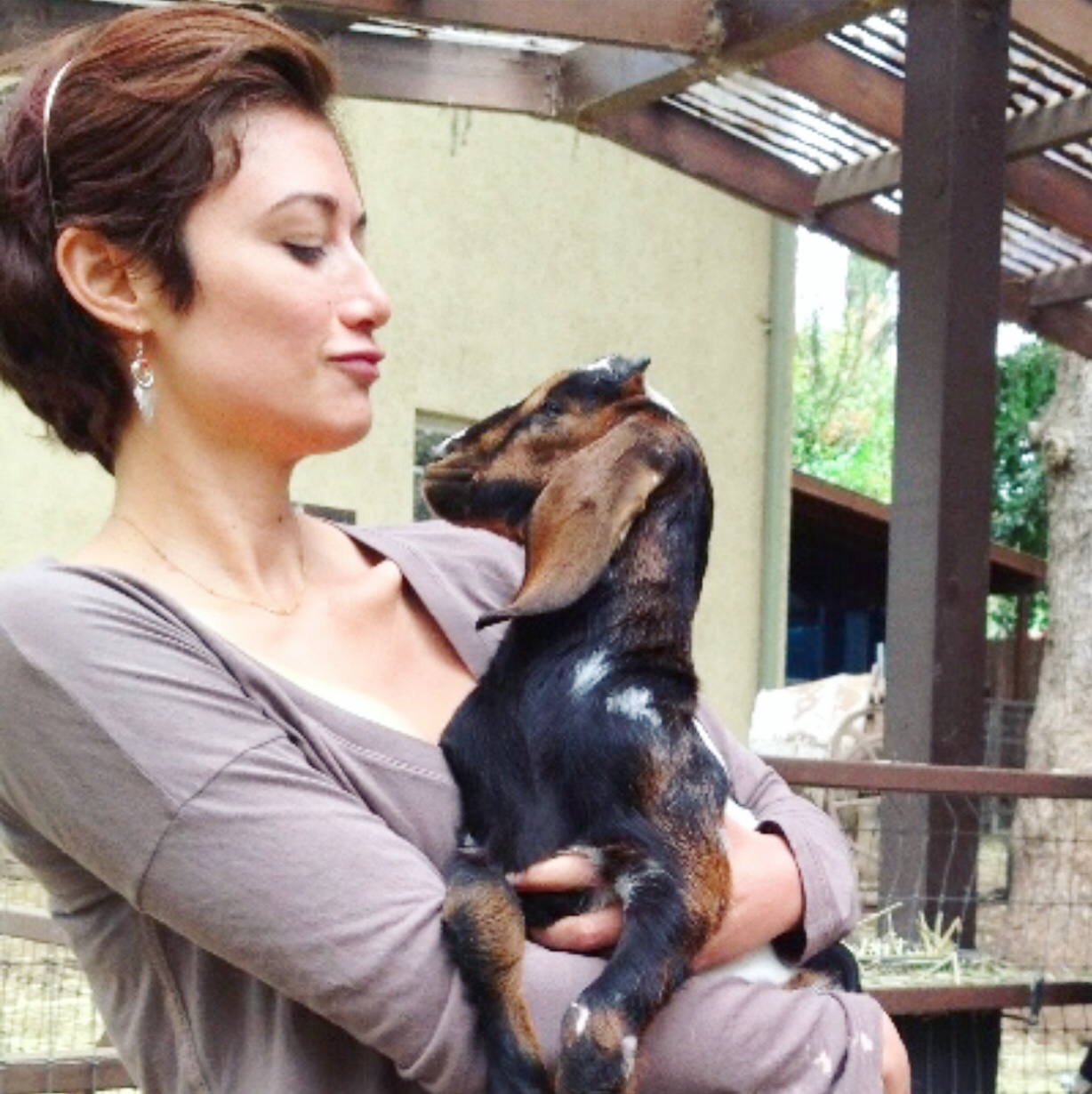There are lots of factors that may lead someone to go dairy-free. For many it’s in the hope of relieving symptoms of lactose intolerance or irritable bowel syndrome. For others it’s to avoid inflammatory responses like heartburn, lack of energy, and joint pain. Some are trying to lower their cholesterol, others are trying to lose excess weight. If you’re suffering from any of these issues you may want to experiment with cutting it out to see if you feel better.
While those are all great reasons to give up dairy, the catalyst for me was not an upset tummy or bloat, in fact it was not a physical symptom at all. For me it was all thanks to a spunky little goat named Ice Cream. I met Ice Cream, ironically enough, at a cheese making class held at a farm in Alta Dena. In class there was a step-by-step discussion on cheese-making, from choosing the right milk to aging. I also learned a few facts that I found somewhat disturbing. For example, one bottle of commercial milk usually contains milk from hundreds of different cows, and cheese is often made with rennet that comes from the lining of baby calves stomachs. To avoid animal rennet you have to look for cheese labeled vegetarian or Kosher, or that has vegetable rennet listed as an ingredient. This information alone wasn’t enough to put me off cheese eating at the time, however. I happily finished class and envisioned impressing my friends with my mozzarella making skills.

After class they let us go out into the pen to meet the baby goats. Immediately, one special little guy caught my eye. He had knobby knees that wobbled while he walked over to me and bellowed for attention. He had the sweetest little goat face you’ve ever seen! The owner of the farm said his legs had been folded up in the womb and hadn’t developed properly. With permission, I scooped him up and held him in my arms. He looked up at me with those big baby browns and, I don’t know how else to describe it, In that moment…we bonded. Ice Cream had won my heart.
 Cut to a couple of weeks later, I was back at the same farm for a class on jam making. Upon arrival I headed out to the corral to say hi to my new friend. There were plenty of goats around but MY GOAT was nowhere to be seen. I flagged down the owner. “Hi!, where’s Ice Cream?” I asked. “Oh you know, we sold him to a chef who wanted to make soup out of him. Ice Cream was a boy and there’s not much use for boys around a dairy farm.” she replied to my dismay. “For how much?” “Forty dollars.” And with that she turned back to shoveling. It was as simple as that. Ice Cream was gone. My head was spinning. Now I don’t know why it never occurred to me that animals had to have a baby in order to make milk, (after all that’s the way it works for us, duh.) but to be honest, I had never really thought about it.
Cut to a couple of weeks later, I was back at the same farm for a class on jam making. Upon arrival I headed out to the corral to say hi to my new friend. There were plenty of goats around but MY GOAT was nowhere to be seen. I flagged down the owner. “Hi!, where’s Ice Cream?” I asked. “Oh you know, we sold him to a chef who wanted to make soup out of him. Ice Cream was a boy and there’s not much use for boys around a dairy farm.” she replied to my dismay. “For how much?” “Forty dollars.” And with that she turned back to shoveling. It was as simple as that. Ice Cream was gone. My head was spinning. Now I don’t know why it never occurred to me that animals had to have a baby in order to make milk, (after all that’s the way it works for us, duh.) but to be honest, I had never really thought about it.
And so began a journey of learning about the dairy industry. Here are a few of the unfortunate facts I came to know along the way about the most common dairy animals, cows-
- Like all mammals, dairy cows must be impregnated in order to produce milk. At most commercial farms they are forcibly impregnated by artificial insemination on what the industry calls the “rape rack” every year.
- Usually within hours of birth, calves are taken away from their mothers. Calves can become so distressed from separation that they become sick, lose weight from not eating, and cry continuously. The mother cow also shows clear signs of mourning. If the calf is female, she is raised to be a dairy cow like her mother. Male calves are sold for veal. Many people consider veal to be cruel, but they don’t realize that veal production is a by-product of the dairy industry.
- Cows in the dairy industry spend their lives in a constant cycle of impregnation, birth, and milking. They are often fed hormones to increase milk production and have just a couple of months of rest between pregnancies.
- Nearly all cows used for dairy in the U.S. are eventually slaughtered for meat. At an average of less than 5 years of age, exhausted cows are considered “spent” and sent to slaughter, and millions of them are eaten by Americans as hamburger. In a natural setting, a cow can live more than 20 years.
Finding all of this out along with looking at photos of the conditions most dairy cows live in was enough to make me want to give up dairy. Now of course there are some small family farms that treat their animals with more respect, but there are certain realities on a dairy farm and the bottom line is always going to be a factor. Even on nice small farms, like the one where I met Ice Cream, where you can tell they really care about the animals; baby boys are seen as little more than a by-product and must be sold for meat.
I’m not writing to preach that dairy-free is the only way to go. Food issues are complicated. For example a lot of vegan recipes (mine included) sub cashews for dairy. Since cashews only grow in the tropics it means they’re being flown in long distances which of course isn’t great for the environment. Is cashew milk really “better” than say organic milk that comes from a local farm where the animals are pasture raised? That’s not really for me to say. What I think is important is to have awareness about how food is produced and to make the informed choice that feels right for you. For me it means saying “no cheese, please.”, all thanks to a little Ice Cream. xJacq
If you are interested in cutting out or down on dairy, one thing that can make it a lot easier is to know how to make tasty dairy replacements at home, so please enjoy these recipes.
